Category Archive: Safe Driving
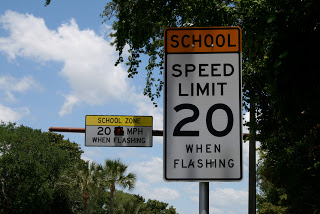
School Zone Safety
October 4, 2012
The next time you’re driving through a school zone, put yourself in the shoes of the students getting on or off the bus and crossing the streets and you’ll know it is a highly unpredictable driving situation. You’ll see extra heavy traffic of parents picking up their kids and the students crossing the street on foot and on their bicycles. After you take in the scene of the organized chaos, you’ll understand why school zone speed limits are strictly enforced.
Here are a few school zone safety tips and all drivers to keep in mind:
Why is it so difficult for children to see motorists? Because their peripheral vision is about one-third narrower than an adult’s, children can’t see a motorist approaching from the right or left as soon as an adult can.
Children also have difficulty judging a car’s speed and distance. They often think that if they can see the driver, the driver can see them.
Drivers should observe speed limits at all times, but especially around children. You were taught during driver education class to always expect children to dart out in the roadway or be unpredictable. So, the next time you’re out expect the unexpected when driving in school zones, near playgrounds, or in neighborhoods where children might be playing and SLOW DOWN.
Always yield to pedestrians. When turning left at a green light or making a right turn on red, drivers need to look for pedestrians as well as cars. Pedestrians always have the right of way in these situations.
When a school bus stops you must stop. Never pass a school bus that is loading or unloading children. Passing a stopped school bus is a four point infraction and is very dangerous.
Around most schools the speed limit is either 15 or 20 mph. Special speed limit signs are posted around schools to alert one as they enter the zone. These signs have flashing lights to tell you when the lower speed limit is in effect. There is also a sign to indicate when you have left the school zone.
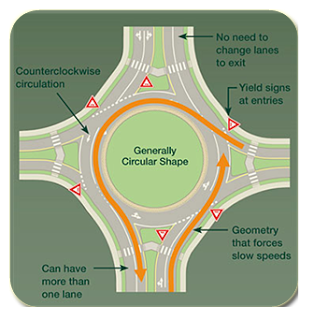
Traffic Circles and Roundabouts
December 1, 2011
Traffic circles and roundabouts are a type of road intersection that are gaining popularity throughout the nation. While not really a new idea, they seem to have become more prevalent over the past fifteen to twenty years as city planners and developers seek ways to keep traffic moving more smoothly and safely.
Traffic circles allow traffic to move more smoothly through an intersection without the use of traffic lights by use of a one way circle with “exits” to the intersecting roads. If you have never encountered one, they could be slightly intimidating at first but they are really quite simple and you will find they do keep traffic moving much more smoothly. They also keep the intersection safer by forcing traffic entering the circle to slow down and yield to traffic already in the circle. While traffic must slow to enter the circle, it doesn’t have to stop for red lights which can be especially frustrating when there is no traffic on the cross street.
Most traffic collisions in the US occur at intersections and the most common type of collisions are rear-end collisions. By slowing traffic on entering and keeping all traffic moving in the same direction, traffic circles cut down on the chances for collisions. With no traffic light, there is a zero chance of someone causing a collision by running a red light.
All traffic circles are designed basically the same way. The terms roundabout and traffic circles are often used interchangeably but traffic circles usually refer to larger, multi-lane circles. Traffic entering the circle must slow, wait for an opening in traffic and then enter to the right moving around the circle in a counterclockwise path. Once a driver reaches the “exit” to the road they want to enter, they exit the circle to the right.
If you live in a growing community, you may want to urge your city planners to consider more traffic circles to cut down on traffic congestion.
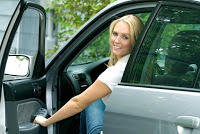
Don’t Let the Grinch Steal Your Christmas
November 21, 2011
For those with long commutes to work and back and those who drive very little, the driving situation during the holidays can be a nightmarish situation. The holiday season is supposed to be about peace on earth and kindness to others but it seems that, once drivers get caught up in the holiday shopping rush, all of that goes out the window and it is every man for himself. To help you cope with the holiday driving situation and keep you safe on the road, here are a few reminders.
Planning – High gasoline prices have led many to consolidate trips to save money. That is also a good tip for the holiday season:
- Create and try to stick to a shopping list for everyone on your gift giving list. You’ll spend less time and money if you know exactly what you are after. Try to avoid browsing that will lead to impulse buying and keep you out longer.
- Shopping online can help you avoid going out into traffic. You can also order items online for pick-up at your local store so you can do a quick in –pickup – and out.
- Try to get all your shopping done in one or two days; that way you can relax and enjoy the rest of the holiday season.
- Shop early! Retailers are trying to lure customers with early sales so they aren’t stuck with a left over inventory.
- Plan on being stuck in traffic and allow yourself plenty of extra time. That way, you won’t be tempted to take chances behind the wheel and you won’t be as frustrated.
Dealing with other drivers – The frenetic pace of the holiday season seems to bring out the worst in some drivers. Don’t let a “Grinch” driver get to you.
- It seems as if no other time of the year results in as many clogged intersections. When drivers pull out into a clogged intersection and the light changes, everyone is stuck. If you can’t clear the intersection, remain behind the white stop line until the traffic ahead moves enough that you can get all the way across. Remember, if you are stuck in the intersection when the light changes, you could get an automatic ticket from a red light camera.
- Remember that you can’t take the right-of-way; you can only give it up to another driver. If someone tries to hog the right-of-way, give it to them. Fighting for the right-of-way or a parking spot isn’t worth the possibility of a collision or a road rage incident.
- Don’t try to retaliate against another driver by yelling, making gestures, or honking your horn. That type of behavior could tip someone over the edge into a road rage situation.
- Remember the F.I.D.O. principle. Forget It and Drive On. There is nothing you can do to change another driver’s behavior. Just let it go and keep out of their way.
Pedestrians – There will be a lot of pedestrians in parking lots and on the roads at this time of year.
- Remember that pedestrians always have the right-of-way.
- Small children are excited and even more impulsive at this time of year. Anticipate that they may run out into traffic.
- Pedestrians may be bundled up against the cold. Hats, mufflers and scarves may interfere with vision and hearing. Count on pedestrians not noticing your approach.
Distractions – As if the driving situation isn’t bad enough during the holiday season, distracted drivers make it worse.
- It is understood that you are in a rush, but try to avoid eating in the car while driving. Trying to eat and drink distracts us from the very important job of watching the road ahead. Giving yourself time to eat in a restaurant will allow you to relax and calm down before going back out into traffic.
- Put the cell phone away! Don’t try to use your cell phone and especially don’t text unless you are pulled safely off the road. Cell phone users tend to slow traffic and you don’t want to add to the congestion.
Have a happy and, above all, a safe holiday season with your loved ones.
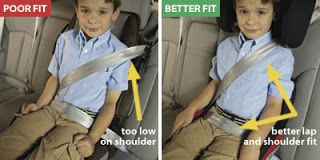
Child Safety Seats Have An Expiration Date
October 14, 2011
In these hard economic times, when parents have a new child on the way, it is often tempting to use a hand-me-down child safety seat or a used child seat purchased from a second hand store but, did you know that child safety seats have expiration dates?
It is a little known fact that child safety seats have expiration dates; usually six years from the manufacture date. There is a very good reason for this. Child safety seats are made from synthetic, petroleum based plastics and fabrics. While these materials are excellent for this purpose and make for a very strong and reliable child protective seat, they are subjected to a lot of harmful environmental factors that can weaken them over the years.
Most child seats remain in the car and internal temperatures inside the car in the summer can easily reach 130 to 140 degrees and over time, this can lead to a breakdown of the plastic materials. Exposure to the sun is also harmful. Synthetic fabrics, especially nylon don’t tolerate long periods of direct exposure to the sun very well. When exposed to the sun over long periods, the synthetic fabrics can become brittle and break; not something you want a safety belt to do.
Read more about: Summer Heat Warnings – Never Leave Children Alone in Cars
So, while a used seat may look perfectly fine, there may be damage that is too small to see that can grow over time. Your little passenger is too precious to take that chance. Most seats have the expiration date embossed in the plastic on the bottom of the seat. When considering a used car seat, check the expiration date and make sure that your child will have outgrown it before it expires.
Parents should also remember that children who outgrow the child safety seat should graduate into a booster seat until they are at least 4’9” tall. Lots of kids are graduated to seat belts too early and their small frames prevent the seat belt from fitting properly low over their hips. If the belt should rise up over their abdomen, they could be injured in a crash.
For more information on child safety seats and booster seats, visit the Insurance Institute for Highway Safety at: http://www.iihs.org/research/topics/child_restraints/default.html
For help in learning how to properly install and use a child seat, the National Highway Traffic Safety Administration has a web site that can direct you to a trained Child Passenger Safety Technician in your area who can teach you how to install your seat, answer any questions you may have, and give you additional information on child safety seats. To locate a Child Passenger Safety Technician, visit: http://www.nhtsa.gov/cps/cpsfitting/index.cfm
Photo: Compliments Insurance Institute for Highway Safety
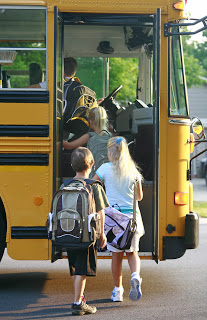
Make your Trip to School a Safe One
October 5, 2011
Word’s out: summer’s officially over. Other than the nationwide-groans from kids, there’s also something else to be concerned about: children’s safety. These kids may be in their preschool years, or they may be at the driving age — bottom line is: pedestrian safety is a still a genuine concern.
Here are some tips both for parents and children to make their daily trip to school a safe one:
- Parents should have a talk with their children regarding safety. For the younger kids, parents should be giving out more specific advice than “don’t talk to strangers.” These talks can and should also include the following topics: looking left to right before crossing, crossing/getting off the bus only where it is allowed or with adult supervision and numbers to call should they find themselves lost. For the older kids, maybe it’s time to introduce a Parent-Teen Driving Contract — to put down in paper what is specifically not allowed in the scope of their driving privilege/responsibility.
- Drive carefully. Be the example for your children. Always buckle your seat belt before driving, remove all distractions from the vehicle and always obey traffic signs or lights. Always keep the vehicle maintained so it doesn’t break down and the kids (or you!) won’t get late.
- If the school is within walking distance from the home, parents should survey the route their children take. Is there a “walking school bus” (a group of kids on their way to school accompanied by an adult from the neighborhood) near the area where you live?
- For parents and teen drivers: always be aware of school zones. The penalties of going too fast or driving up where you’re not supposed to is even greater than when you’re on the road — even worse, you may get in an accident. Remember that there is a speed limit of 25mph in school zones which apply before and after school hours.
- Have fun: school may end up being the best time for children, and a fond memory for parents. Making sure you and your family is safe ensures that you’ll cherish the moment more.
